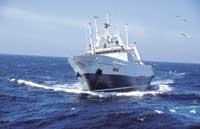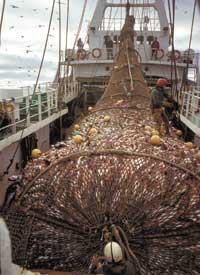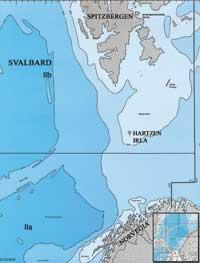Where is Terranova cod?

According to some historians, the first traces of cod fishing date back to the year 1000, when the Vikings fished cod on the Scandinavian coast. For a long time, Basque fishermen left the Bay of Biscay and immersed themselves in European waters following cod, since in the Cantabrian there was, at least in quantities, no live cod. Despite not being pioneers in the fishing of cod, according to some authors, it was they who developed the technique of salting cod, which unexpectedly caused numerous advantages. On the one hand, it allowed to keep the fish without deteriorating for a long time, thus becoming the ideal food for long trips. Salty cod was the way for distant seas and unknown lands to become us and so the Basque ships sought new fisheries in the cold waters of the North Atlantic.
In addition, it offered the possibility of extending both to the Spanish market and abroad. Christianity also boosted the importance of salted cod, as the ban on eating meat on Fridays in Lent made cod the main complement to the diet.
Pair Drag The couple fishing, as the name suggests, is done between two boats. Each container has its own sock-like drag net. One of them is the net that is first thrown into the water. A fishing boat holds the net by one end, among others, dragging it down the bottom. Then the collection of the network is proceeded and immediately the discharge of the second network to the water. This way several fisheries are carried out daily. |

We cannot forget the relationship between whale fishing and cod. The extension of whale hunting to remote areas allowed for foods that would not spoil in the long run, such as salt cod. Thus, following the whales, they moved away from unknown lands and places, namely Labrador and Ternua. The whales came in summer to these cold waters in search of food and behind them the Basque fishermen. Summer was spent there in the rainfed whaling camps. In addition to the abundance of whales, they realized that cod was very abundant and began fishing the latter.
Thus, the Basques became landowners. Subsequently, the relationship between the two peoples has been close and the Basque toponyms that still exist in Newfoundland remind us. As an example, mention that the name of the local capital is Saint Johns, since at the arrival of fishermen from Euskal Herria recalled the entry of the port of Donibane (San Juan in Spanish). In this large list of examples we can also find the names of Portutxo or Port Basque and Aingura charra (former).

The sounds of abundance of Terranova cod spread at full speed among the fishermen of Euskal Herria and Europe, and most fishermen were making plans to go there. Since then, cod fishing around Newfoundland was very important for our fishermen. In principle, XVI and XVII. For centuries, fishing was carried out by small boats in the shade of the big boats, using hooks and anglers. While the big boat was docked on the coast, the small boats were headed for cod fishing and after jumping in the dry catch, they were stacked in the big fishing boat. Then, XVIII. In the 20th century, large trawlers were responsible for fishing cod with bottom trawling nets. XX. From the 20th century, cod fishing moved to the trawling fishery between two boats, trawling by pairs, and is still practiced today.
XX. In the eighteenth century, specifically between 1950 and 1985, the port of Pasajes knew its golden age and was the main driver of cod fishing. In those times there were many couples who could not fit in the port of Pasaia and large cod companies such as PYSBE controlled the cod market. Unfortunately, those times have been far away and since then the capture of cod and, by the way, the number of cod has decreased considerably.
Decline of cod and Terranova cod fishing

Currently cod catches in Newfoundland are negligible. The trips of pairs of coaches that were once normal have become something unusual and these days it is not normal to hear the stories of the captains and sailors of ancient George Kala, Kala Handia, Saint Pierre Kalea. Normally two trips were made, one from the beginning of the year to summer and the other from summer to Christmas. They always suffered the sunless winter of those lands: endless nights, unbearable cold, ice and endless snow... They had only a dream of overcoming that suffering: a fishing of hundreds of tons to spread the joy of the family when returning to Pasaia.
But what have been the reasons for these changes? Why has the presence of Basque vessels in Newfoundland been reduced? Why has the cod population declined? Fisheries, catches and fishing boats are some of the causes of different origin.
On the one hand we have political reasons, among them the decisive one was given in 1977 with the application of the Canada Fisheries Region Act of 200 nautical miles. What until then was a fishery of all, became Canadian and the coves that for hundreds of years were fished for the bakers were closed overnight. The fleet that until then operated in Canada, especially in the Gran Cala, found the only solution to face the new situation in a region much smaller than the Gran Cala. The evident result of fishing in smaller areas was the reduction of fishing resources, which caused that for an immense number of perpetrators, the Newfoundland wind had dragged the profitability offered by fishing until then. Although many boats disappeared for this reason, there were still couples fishing out of 200 miles.
Following the implementation of the 200 mile law, and although it may seem surprising, fifteen years later, there was a spectacular decline in all resources of Terranova cod fishing: Of the 600,000 tons of fishing, catches became null. Unlike what was happening at first, the decline by the interaction of several factors is now unanimously accepted. In the following lines we will highlight the reasons presented by different researchers.
Influence of overfishing
For some, the main cause was overexploitation. Although the Canadians have repeatedly blamed the Basque, Spanish and Portuguese fleet, it is best for all boats that fished there (including Canadians). Canadian public opinion also culminates with the role of its scientists in evaluating the cod population. These two facts made possible the decline of the precious treasure.
In those times, due to the good health of the population of Terrano-Cod, it was thought that the catches would not have negative effects on the population; moreover, in those years it was not taken into account that much more fish was disembarked than declared by the fishermen and that the huge tacs ( Total Allowable Catch: Authorized Total Catches were established) without suspecting the decline of the cod population. Thus, when in the expert reports the situation of cod became worrying, it was too late and there was no retreat.
However, in recent years, and for the tranquility of scientists, some clues are being discovered about the causes of cod fall. On the one hand, the excessive optimism of the aforementioned scientists, the estimation above the population and the overexploitation, but also the influence of environmental factors. This influence is increasingly important and a stop will provide some explanations.
Influence of environmental factors

The constant cooling of the waters of the Ternua area makes the water in the area cooler than when it was a thriving fishery. This cooling of water has led to the decline of species such as cod (favoured by warmer temperatures) and the rise of other artico-boreal species. But why has that happened? On the one hand, cod does not feed in spawning season and is supplied with reserves collected the previous year, so that at the end of the laying time is in a very weak, critical situation. Shortly after the set time, he starts eating non-stop to recover lost reserves. Various research has concluded that in this critical period cold water temperature can cause high mortality.
In addition to shortening the season of cod laying due to low temperatures, fish spawn less and, therefore, the possibility that the following generations will succeed. Also, a response given by the cod population to overexploitation has been to reach maturity at an earlier age. Thus, although it was considered that this effect could be useful for the recovery of the population, it has been shown that the survival of the generations produced by the young specimens is less, since the amount of eggs first thrown into the water and its quality is much lower.
Other research has shown that cod consumption by seals is spectacular, of which about 250 thousand tons of cod die per year. In recent years, in addition to eating whole cods, seals sometimes attack large cods eating only their liver, which causes the death of a greater amount of cod.
Faced with this spectacular decline in the cod population, the Northwest Atlantic Fishing Association (NAFO: Northwest Atlantic Fisheries Organization) in 1992 banned cod fishing and since then the ban continues. The recovery of local populations has not yet been noticed and in the near future the times to see Terranova cod in our dishes are far away.
And in NorwaySo where does the cod that we like so much come from now? Where do we fish that precious fish we see and buy in the square? Boats that historically engaged in the fishing of Terranova cod, from time to time, especially when they were scarce fisheries, set off to the East Atlantic in search of more prosperous fisheries. Thus, Basque coasts obtained historical rights in the Svalbard cod fishery in northern Norway.

Although Svalbard is out of 200 miles from Norway, his control focuses on Norway and Russia. Unlike Newfoundland, the cod population of Svalbard enjoys good health and catches in recent years equate to the historical maximum (between 95-98 some 800,000 tons were captured). A small part of the fishing carried out in it is carried out by the Basque ships and each summer they leave for Svalbard to capture the amount of fish that corresponds to them. Normally the exits to the sea extend until the corresponding quota fishing and, although it varies from year to year, they return in three or four months.
However, the share of Basque ships is negligible compared to Newfoundland, and although Basque cod catches have been reduced, our desire to eat cod has not diminished. So how do we satisfy our cod desires? Most of the cod we bring on the market is imported from abroad, that is, captured by ships from other countries.
The future of Basque cod fishingThe cod journey has already taken us back and forth from the Atlantic, but what future have those who have been the cod fisheries of the Basques over the years? Although most fisheries in the world have a black cloud, we would like to be optimistic.
If we look to Ternua the situation is hard, but we should not lose hope because in the long run things can change. In recent years there have been some changes in the environment that increase hope. It seems that the water temperature is increasing, which will undoubtedly contribute to the recovery of the cod population.
In the Svalbard area the red light has already been lit. Scientists have denounced that catches in recent years are unsustainable and believe that the local cod population can support between 350-400 thousand tons. We hope that in this case “belief is not half corrupt”.
Although the trip narrated has been of your liking or not, it cannot be finished without the mention made by Mark Kurlansky of a Basque tale in his book Cod (cod): “… that the cod was able to speak was not at all surprising, but he was aware that he spoke in an unknown language. He spoke Basque.” So we hope that we enjoy each other a lot. Do well.
Cod
(Gadus morhua)
Cod (Gadus morhua) is very common on both sides of the North Atlantic, from southern Canada to Greenland above St. Lawrence and Newfoundland, and eastward to Iceland, the North Sea, Norway and the island of Svalbard. Cod is a fish that inhabits a depth of 0-400 meters and likes cold water (2-5ºC). Cod is a member of the large dadidae family, as well as: Greenland cod (Gadus ogac) and Pacific cod (Gadus macrocephalus).

Cod is a soft green brown bark fish that lives up to 20 years. He has his face full of mouth, big eyes and beard on his chin. It can reach 160 cm in length and 40 kg in weight. Every year it increases by about 10 centimeters and there are no significant differences in growth between females and males. Most specimens reach maturity between 6 and 8 years. The reproductive time, although uneven on both sides of the North Atlantic, occurs in the spring-winter and in the summer, due to the effort made during the setting, is dedicated to feeding to recover.
Cod is one of the most breeding fish species known in the sea and that each female can spawn between 1,000 and 18,000,000 eggs each year. We have enough miles to eat, it is a selective species and therefore it does not eat everything. Both Newfoundland and Svalbad have their precious food capelin (Mallotus villosus), as a second dish with the amphibian and other enough fish. However, in the years of shortage of capelines usually have no problem eating smaller people. In these years there is a high rate of cannibalism.





